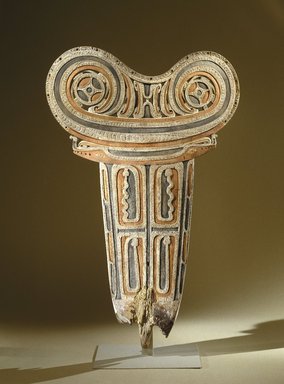
Medium: Wood, pigment
Geograhical Locations:
Dates:20th century
Dimensions: 51 1/2 x 32 3/4 x 3 1/2 in. (130.8 x 83.2 x 8.9 cm)
Collections:
Accession Number: 80.2
Image: 80.2_SL1.jpg,
Catalogue Description: A carved and openwork wooden canoe prow board called a 'canoe breakwater.' At the top are two large lobes, a configuration resembling a horizontal figure eight. Below this configuration is a long panel. The board is slightly convex from side to side. The front is carved in low relief with designs picked out in black, white and red pigments. The top has an elaborate openwork scroll pattern in low relief giving the effect of flattened spirals that are linked. The scroll pattern is derived from bird heads and beaks, probably the frigate bird. There are two segmented disks in the center of each lobe. The rim around the top has regularly spaced perforations. Immediately below the lobe configuration are two bands, each terminating at the sides in bird heads. The lower panel section has been divided in four rectangular sections, two at the top and two below. There is a serpent depiction in each panel; the ones at the top have wriggling bodies. The back is plain, but at the top on the left side, written in black, is the word "YANABA." Condition: Excellent. There are very small holes on front and back surfaces, the result of old insect damage. Slight loss of surface where insect tunnels have collapsed. The bottom front shows evidence of water damage, particularly on left side and there has been erosion of the wood. This area is also flaking slightly and must be handled with care. Some erosion and discoloration from water visible on back, particularly on sides of panel section. There are two nails visible on lower right side in the back. Small loss from erosion on top edge near center on left side.